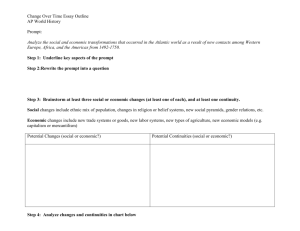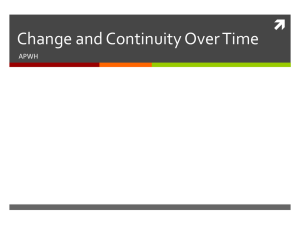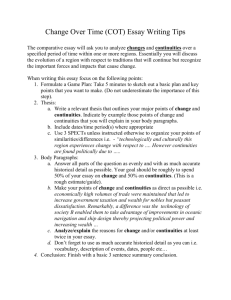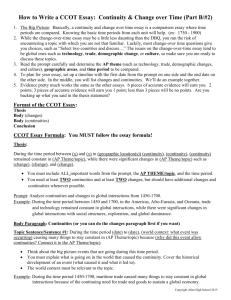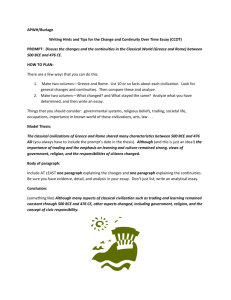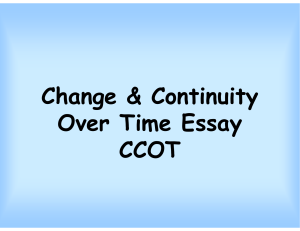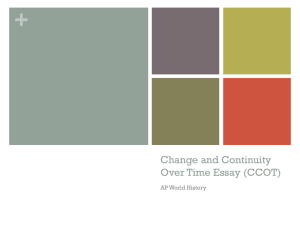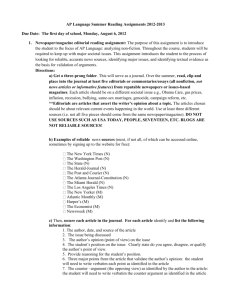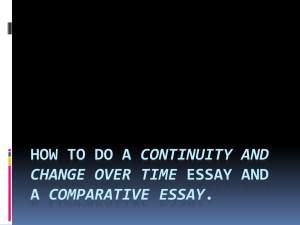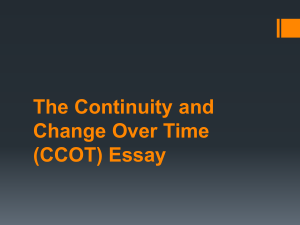How to Write a CCOT Essay
advertisement
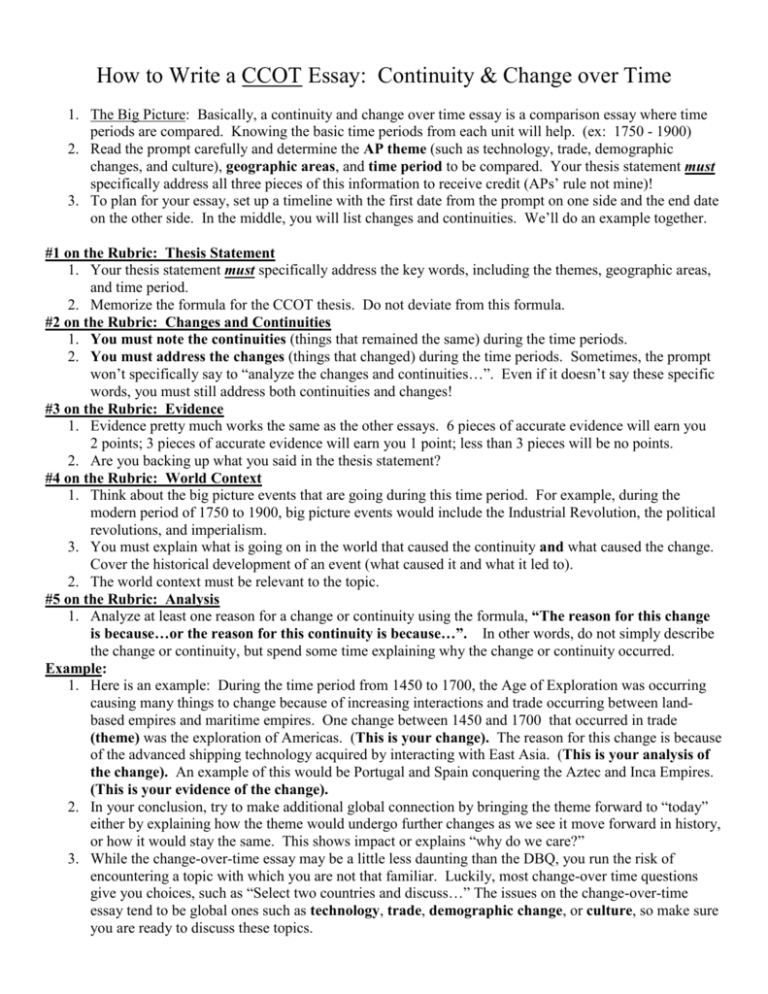
How to Write a CCOT Essay: Continuity & Change over Time 1. The Big Picture: Basically, a continuity and change over time essay is a comparison essay where time periods are compared. Knowing the basic time periods from each unit will help. (ex: 1750 - 1900) 2. Read the prompt carefully and determine the AP theme (such as technology, trade, demographic changes, and culture), geographic areas, and time period to be compared. Your thesis statement must specifically address all three pieces of this information to receive credit (APs’ rule not mine)! 3. To plan for your essay, set up a timeline with the first date from the prompt on one side and the end date on the other side. In the middle, you will list changes and continuities. We’ll do an example together. #1 on the Rubric: Thesis Statement 1. Your thesis statement must specifically address the key words, including the themes, geographic areas, and time period. 2. Memorize the formula for the CCOT thesis. Do not deviate from this formula. #2 on the Rubric: Changes and Continuities 1. You must note the continuities (things that remained the same) during the time periods. 2. You must address the changes (things that changed) during the time periods. Sometimes, the prompt won’t specifically say to “analyze the changes and continuities…”. Even if it doesn’t say these specific words, you must still address both continuities and changes! #3 on the Rubric: Evidence 1. Evidence pretty much works the same as the other essays. 6 pieces of accurate evidence will earn you 2 points; 3 pieces of accurate evidence will earn you 1 point; less than 3 pieces will be no points. 2. Are you backing up what you said in the thesis statement? #4 on the Rubric: World Context 1. Think about the big picture events that are going during this time period. For example, during the modern period of 1750 to 1900, big picture events would include the Industrial Revolution, the political revolutions, and imperialism. 3. You must explain what is going on in the world that caused the continuity and what caused the change. Cover the historical development of an event (what caused it and what it led to). 2. The world context must be relevant to the topic. #5 on the Rubric: Analysis 1. Analyze at least one reason for a change or continuity using the formula, “The reason for this change is because…or the reason for this continuity is because…”. In other words, do not simply describe the change or continuity, but spend some time explaining why the change or continuity occurred. Example: 1. Here is an example: During the time period from 1450 to 1700, the Age of Exploration was occurring causing many things to change because of increasing interactions and trade occurring between landbased empires and maritime empires. One change between 1450 and 1700 that occurred in trade (theme) was the exploration of Americas. (This is your change). The reason for this change is because of the advanced shipping technology acquired by interacting with East Asia. (This is your analysis of the change). An example of this would be Portugal and Spain conquering the Aztec and Inca Empires. (This is your evidence of the change). 2. In your conclusion, try to make additional global connection by bringing the theme forward to “today” either by explaining how the theme would undergo further changes as we see it move forward in history, or how it would stay the same. This shows impact or explains “why do we care?” 3. While the change-over-time essay may be a little less daunting than the DBQ, you run the risk of encountering a topic with which you are not that familiar. Luckily, most change-over time questions give you choices, such as “Select two countries and discuss…” The issues on the change-over-time essay tend to be global ones such as technology, trade, demographic change, or culture, so make sure you are ready to discuss these topics. Format of the CCOT Essay: Thesis Body (changes) Body (continuities) Conclusion CCOT Essay Formula: Thesis: During the time period between (x) and (y) in (geographic location(s)) (category), (category), (category) remained constant in (AP Theme), while there were significant changes in (AP Theme) such as (category), (category), and (category). You need at least TWO continuities and at least TWO changes, but can have more of one than the other. Include ALL important words from the prompt, including the AP THEME. Body Paragraph: Continuities (or you can do changes first if you want) Topic Sentence: During the time period (date) to (date), (world context: what event was occurring) causing many things to stay constant because (why did this event allow continuities?). Repeat the following formula at least two times (depending on how many continuities): One continuity between (dates) that occurred in (AP Theme) was (first category). The reason for this continuity is because (analysis). An example of this would be (evidence needs to be specific of the AP Theme). Repeat at least once more – two would be best. Body Paragraph: Changes (or you can do continuities second if you want) Topic Sentence: During the time period (date) to (date), (world context: what event was occurring; can be the same or another event that occurred during the time period) causing many things to change because (why did this event cause changes?). Repeat the following formula at least two times (depending on how many changes): One change between (dates) that occurred in (AP Theme) was (first category). The reason for this change is because (analysis). An example of this would be (evidence needs to be specific of the AP Theme). Repeat at least once more – two would be best. Conclusion – See #2 on the reverse side
